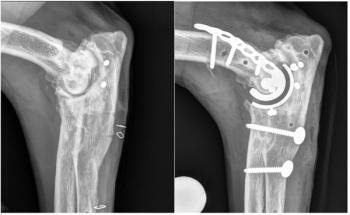
Image quiz: Whats causing this puppys strange gait?
Are you an X-ray expert? Test your skills with this case of an unsteady standard poodle pup.
An 11-week-old male standard poodle was evaluated for a strange gait in his left front limb. A nonpainful, firm swelling was palpated over the lateral aspect of his left elbow. Other physical examination findings included severe prognathism and an umbilical hernia. The patient's testes had not yet descended even though this was not the case with his other littermates. Based on the puppy's history and physical examination findings, radiographs of both forelimbs were obtained.
Lateral view, left | All images provided by Dr. Betsy Charles
Lateral view, right
Cranial caudal viewWhat's your most likely radiographic diagnosis?
A. A traumatic elbow luxation
B. An angular limb deformity due to premature closure of the distal radial physis
C. Congenital elbow luxation
D. Elbow incongruity
Click to the next page for the answer.
The correct answer is C, congenital elbow luxation.
Dr. Charles' quick tips on a digital radiography system purchase
Most of the digital radiography systems provide high-quality images, and though I could get picky about algorithms and all the stuff radiologists love to get picky about, my advice centers on ease of use and ability to integrate the system into the day-to-day operations of your practice. Of course, you need to think about your needs, such as the number of films you're taking, image storage options and costs, teleradiology needs, whether the system work with your electronic medical record and whether the system is user-friendly. But if you can't integrate the system into your practice easily, you will never reach the awesome potential that digital radiology can add for your patients. Go with what works best for you!
Congenital elbow luxation (CEL) in dogs is classified into three types: humeroradial (Type I), humeroulnar (Type II) and combined humeroradial and humeroulnar (Type III)-the most common being humeroulnar.1,2 Type I is more common in large-breed dogs, while Type II is more common in small-breed dogs.3 CEL can be unilateral or bilateral, so it's important to obtain radiographs of both limbs.
In this case, the radiographs revealed caudal and lateral displacement of the left radial head with an open distal radial physis, findings that are most consistent with Type I CEL. Traumatic luxation is not considered possible in light of the radiographic appearance, the patient's age and the physical examination findings. No radiographic evidence of osteoarthritis was seen, but it will likely develop over time. The right elbow was normal radiographically.
Treatment options depend on the severity of the pathology. If the clinical signs are mild, you can try conservative management, but if the patient develops pain, the luxation worsens or significant bone remodeling is present, surgical intervention may be necessary.3
References
1. Kene RC, Lee R, Bennett D. The radiological features of congenital elbow luxation/subluxation in the dog. J Small Anim Pract 1982;23(10):621-630.
2. Rahal SC, De Biasi F, Vulcano LC, et al. Reduction of humeroulnar congenital elbow luxation in 8 dogs by using the transarticular pin. Can Vet J 2000;41:849-853.
3. Fafard AR. Unilateral congenital elbow luxation in a dachshund. Can Vet J 2006;47:909-912.
Editor's note: This article has been modified from the original. An earlier version incorrectly stated, "The radiographs also revealed aplasia of the medial eipicondyle." That sentence was removed because the medial epicondyle is present and is superimposed over the distal humerus. The earlier version also incorrectly stated, "Traumatic luxation can't be entirely ruled out, but in light of the patient's age, the physical examination findings (including the other abnormalities), this diagnosis is considered much less likely.” That sentence has been corrected to "Traumatic luxation is not considered possible in light of the radiographic appearance, the patient's age and the physical examination findings.”
Newsletter
From exam room tips to practice management insights, get trusted veterinary news delivered straight to your inbox—subscribe to dvm360.






